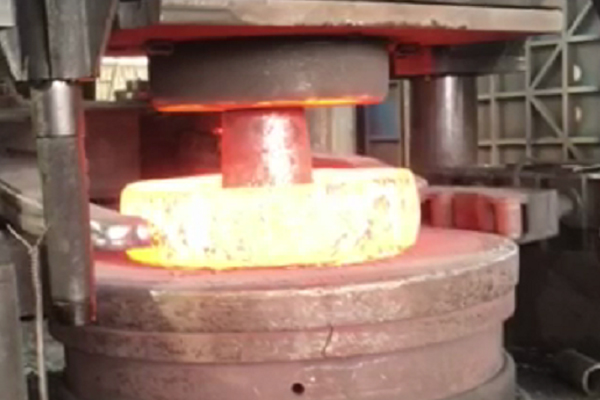The oxidation of forgings is mainly affected by the chemical composition of the heated metal and the internal and external factors of the heating ring (such as furnace gas composition, heating temperature, etc.).
1) Chemical composition of metal materials
The amount of oxide scale formed is closely related to the chemical composition. The higher the carbon content of steel, the less oxide scale is formed, especially when the carbon content exceeds 0.3%. This is because after the carbon is oxidized, a layer of monoxide (CO) gas is formed on the surface of the blank, which plays a role in inhibiting the continued oxidation. Alloy steel in Cr, Ni, Al, Mo, Si and other elements, the more heating when the formation of the scale is less, because these elements were oxidized, can form a layer on the surface of steel dense oxide film, and it and steel has close to the thermal expansion coefficient, and firmly attached to the surface, is not easy to break and fall off, so to prevent further oxidation, protection. Heat-resistant non-peeling steel is alloy steel with more of the above elements, and when the content of Ni and Cr in the steel is 13%? At 20%, almost no oxidation occurs.
2) Furnace gas composition
Furnace gas composition has a great influence on the formation of forging scale, the same steel forgings in different heating atmosphere, the formation of the scale is not the same, in the oxidizing furnace gas, the formation of the scale is the most, light gray, easy to remove; In neutral furnace gas (mainly containing N2) and reducing furnace gas (containing CO, H2, etc.), the oxide scale formed is less black and is not easy to remove. In order to minimize the formation and removal of oxide scale, attention should be paid to the control of furnace gas composition at each stage of heating. Generally speaking, forgings are below 1000℃, and oxidized furnace gas is used when heating, because the temperature is not high at this time, the oxidation process is not very severe, and the oxide scale formed is easy to remove; When the temperature exceeds 1000 ℃, especially in the high temperature holding stage, reducing furnace gas or neutral furnace gas should be used to reduce the production of oxide scale.
The nature of the furnace gas in the flame heating furnace depends on the amount of air supplied to the fuel during combustion. If the excess coefficient of air in the furnace is too large, the supply of air is too much, the furnace gas is oxidized, the metal oxide scale is more, if the excess coefficient of air in the furnace is 0.4? At 0.5, the furnace gas is reducible, forming a protective atmosphere to avoid the formation of oxide scale and achieve no oxidation heating.
3) Heating temperature
The heating temperature is also the main factor of forging scale formation, the higher the heating temperature, the more intense the oxidation. In the 570 ℃? Before 600℃, forging oxidation is slow, from 700℃ oxidation speed accelerated, to 900℃? At 950℃, oxidation is very significant. If the oxidation rate is assumed to be 1 at 900 ° C, 2 at 1000 ° C, 3.5 at 1100 ° C, and 7 at 1300 ° C, an increase of six times.
4) Heating time
The longer the heating time of the forgings in the oxidizing gas in the furnace, the greater the oxidation diffusion, and the more the oxide scale is formed, especially in the high temperature heating stage, so the heating time should be reduced as far as possible, especially the heating time and holding time at high temperature should be shortened as far as possible.
In addition, the forging billet at high temperature is not only oxidized in the furnace, but also in the forging process, although the oxide scale on the billet is cleaned, if the billet temperature is still high, it will be oxidized twice, but the oxidation rate gradually weakens with the decrease of the billet temperature.
Post time: Aug-20-2021

